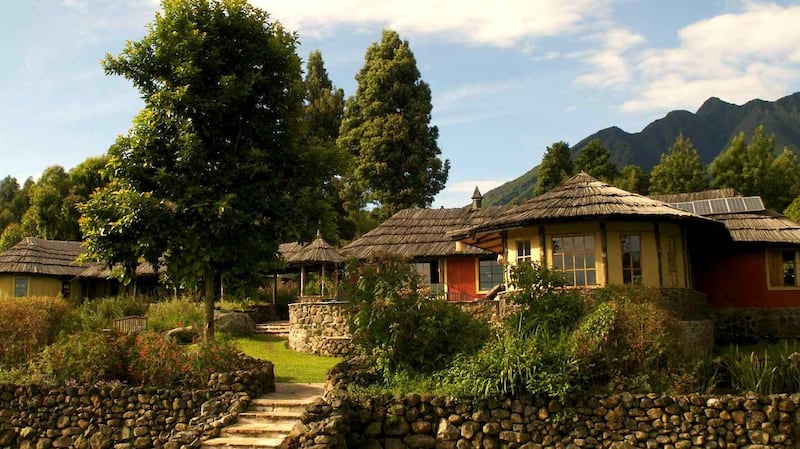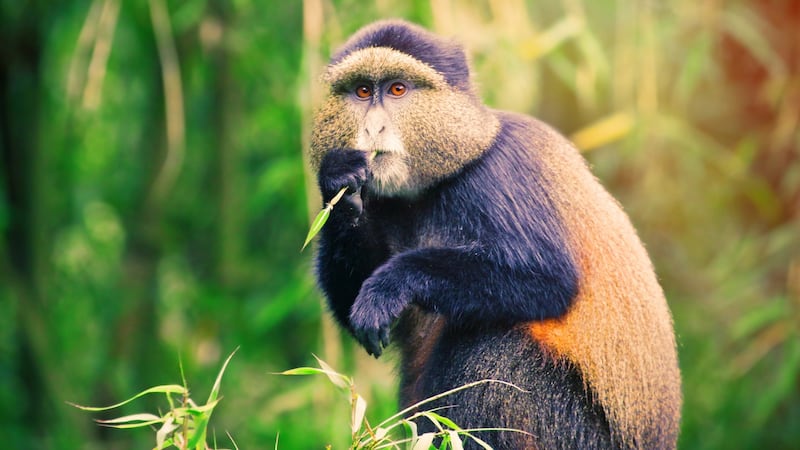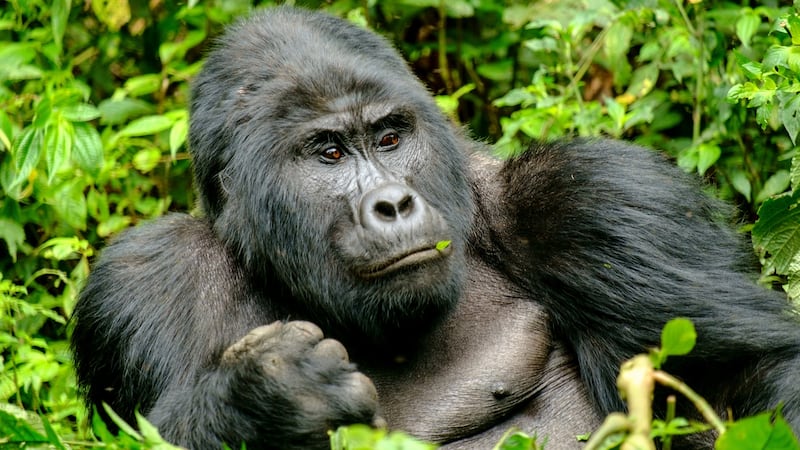Trekking mountain gorillas is a once-in-a-lifetime experience. It instantly evokes David Attenborough's remarkable interactions in dense forests, or the life of Dian Fossey as depicted in Gorillas In the Mist. It's a costly and sometimes physically testing excursion, but one you'll never forget.
The planet's entire population of mountain gorillas resides between Bwindi Impenetrable National Park in Uganda and three national parks in the Virunga Mountains; Mgahinga Gorilla National Park in Uganda, Volcanoes National Park in Rwanda, and Virunga National Park in the Democratic Republic of Congo (DRC) .
The latter closed to tourism last summer until further notice following the deaths of at least a dozen rangers within 10 months in various clashes with militia and the abduction of two British tourists. The tourists, who were gorilla trekking at the time of their kidnapping, were subsequently freed.
Volcanoes Safaris is a luxury lodge and ecotourism company in Uganda and Rwanda. They have three lodges relevant to mountain gorilla trekking; Virunga Lodge in Rwanda, and Mount Gahinga and Bwindi Lodge in Uganda, as well as a fourth lodge – Kyambura Gorge – for trekking chimpanzee in Uganda.
Founded in 1997 by Praveen Moman, who grew up in Uganda before moving to the UK as a refugee during the reign of Idi Amin, the company has been central to gorilla tourism in both Rwanda and Uganda, with a focus on sustainability and employing local staff.
There are around 1,000 mountain gorillas in the wild. While this is a small number it has increased from 680 in 2008, and a brutally low 242 in 1981. Mountain gorillas are the only great ape population increasing in number. Nevertheless they remain under threat from habitat destruction, poaching, and civil unrest and war.
I travelled to three of Volcanoes’ lodges; Mount Gahinga, where we trekked golden monkeys, Bwindi, our base for gorilla trekking, and then Virunga (Rwanda), a breathtaking setting high on a ridge with Lake Bulera and Lake Ruhondo on either side.
Accommodation is in individual cabins in beautifully landscaped grounds sensitive to their environment. Coffee or hot chocolate is delivered to your room in the morning, there is an attentive individual butler service, massages are available to ease your muscles after trekking, and the food is excellent.
Mountain gorilla trekking requires a permit which costs $600 in Uganda and $1,500 in Rwanda. A permit in the DRC costs $400, but it is simply not safe to trek gorillas in Virunga National Park right now. You will also need an East African Tourist Visa, and entry and exit stamps between Rwanda and Uganda, which you get in offices on the border.
Rwandan genocide
After flying to Kigali via Addis Ababa on Ethiopian Airlines, I stayed at the Hotel des Mille Collines, also known as Hotel Rwanda, where Paul and Tatiana Rusesabagina shielded over 1,200 Tutsi refugees during the Rwandan genocide.
It's well worth hanging around Kigali for a couple of days. The city prides itself on being the cleanest city in Africa. It's difficult to imagine spending time in a capital city without seeing a single piece of rubbish on the ground, but that's Kigali.

Rwanda produces the best coffee in the world, the result of a strategy focusing on high-quality, speciality coffee-growing which thrives thanks to the country’s volcanic soil and high altitudes. The very cool Question Coffee cafe in Kigali is a great place to buy and drink truly excellent coffee.
All of this is obviously very removed from the 1994 genocide and its aftermath. Around 800,000 Rwandans were slaughtered in 100 days, and another two million displaced. For context on this horror, a visit to the Kigali Genocide Memorial Centre is essential. An estimated 250,000 genocide victims are also buried here in mass graves. Some 25 years after around 250,000 women were raped during the genocide, Rwanda elected the highest proportion of female MPs of any country (currently 61 per cent) in two successive elections.
Driving towards the Ugandan border, vervet monkeys play at the side of the road, man-made beehives crowd branches of trees, a vulture stares from the gable of a market building. We pass a coffee-washing station, a sweet potato market, coffee dries by the roadside, and pineapple, sugarcane and cassava grow. The main roads in Rwanda are in great condition, less so in Uganda.
At Mount Gahinga Lodge the famous mist wraps itself around the towering extinct volcanoes. The dampness is extreme, permeating clothing and the air. From here we trek through the forest looking for golden monkeys. Just a few minutes into the trek the guide is shocked by the appearance of a forest elephant, a rare sighting. Around the corner two massive buffalo plod away.
The trail gives way to a stunning and spooky bamboo forest, and as torrential rain descends an hour or so into the trek we hear the rustling of endangered golden monkeys above. Found only in this habitat of the Virunga mountains, they leap overhead, stuffing their chubby cheeks with fruit.
Staying at Mount Gahinga provides an opportunity to learn about the Batwa people (pejoratively called pygmies) who are the human victims of conservation, evicted from the forests in the early 1990s so that national parks could be created. At the lodge they demonstrate ancient techniques such as making fire, and shooting with bows and arrows. Through a translator they discuss various herbs and plant-based remedies, including a mixture for the shock caused by grief. When they ask what remedies exist in European culture for grieving, the question stumps the group.
From this lodge we drive to Kisoro, then take a small plane for a 15-minute flight to Kihihi. The mountain gorilla trek is getting closer, the plane flying over Bwindi Impenetrable Forest, an astonishing sight. The hills stretch on and on, a fairytale land of bumps, ridges, and dreamlike lakes, with forest so dense it looks like broccoli from above.
Wall of forest
The lodge at Bwindi is stunning, facing a wall of forest from which emerges a constant cacophony of bird sounds. Louder still are the occasional ruckuses caused by baboons feasting on the massive avocados that hang from trees. Tea also grows at the lodge – you can partake in a tea-tasting experience – and the small tea plantation doubles as a natural fence between the apes and guests as gorillas hate the taste of the plants.
The trek begins early in the morning. Although the length of a trek cannot be guaranteed, the rangers head out earlier, or even stay overnight, to track the gorillas, and transmit that information back to base. At the safety briefing three trekking options are offered; a long trek, a medium-length one or a short trek. Our group opts for the medium trek, but again, as we find out, there is no guarantee as to how long it will actually take.

For trekking you need decent hiking boots, full-length walking trousers, gaiters, a wicking T-shirt, gardening gloves, and a waterproof jacket. If you have long hair like me you also need to tie it up tightly as gorillas are very curious when it comes to long hair and they may approach and yank on it.
After a safety briefing we set out. Walking for an hour or so uphill on dirt trails and ledges, we reached the edge of the forest, a foreboding wall of foliage. “Impenetrable” is not just a name, the forest is extraordinarily dense and only accessible on foot.
Half of the world’s mountain gorillas live here, and elsewhere in the forest there are wild chimpanzees. You hear the words “habituated” and “non-habituated” a lot while preparing for a trek. Habituated means that although living completely in the wild the gorillas you will track are used to seeing humans, and therefore don’t run away or attack.
Nevertheless, we were accompanied by at least one armed guide. Non-habituated gorillas and wild chimpanzees also live in this forest. The habituation process takes two to three years.
Deep vegetation
The atmosphere changed completely in the forest. The rain started, and silence descended as guides led the way. After scrambling down a steep bank, one of the guides raised his hand. We knelt in deep vegetation. A few metres ahead of us, sitting amongst bushes and trees, was a silverback mountain gorilla.
Something rustled to his right, and out of the green a female gorilla slowly strolled on all fours with a baby gorilla on her back. The scene was spectacular. As the gorillas ambled off, we followed them from a safe distance.

Climbing up another steep mud bank, grabbing roots for support, we settled on a muddy ridge, with a large group of gorillas in front of us, many up trees, feeding. There we sat and watched their afternoon scene unfold; gorillas sliding down trees, wandering high eating in the branches above, farting incessantly, baby gorillas playing and mimicking the chest-beating of their elders.
While we stayed back at least the required seven metres from the animals, when they began to move off the gorillas walked mere feet in front of us. The experience was surreal and spectacular. More than anything else, it was profoundly moving. Unlike raucous chimps, gorillas move quietly and gently, and observing them go about their lives is a strangely serene experience.
As we made our way out of the forest, gigantic trees towering above us, clouded in ghostly mist, I began to enjoy the remarkable beauty of the place. It was incredibly moving to be in this otherworldly setting, a place I only knew from the most evocative of nature documentaries. And there I was, in it.
Eyes watching
Awesome is a word that’s thrown around a lot, but the sound of torrential rain hitting leaves, the dampness that no amount of expensive hiking gear can deflect, the smell of unidentifiable flowers, the squelch of mud, the umpteenth fall while trying to navigate terrain that washed away before me in the rain, the sense of hundreds of eyes watching – the eyes of African golden cats, or black and white colobus monkeys, or the eyes of giant forest hogs, or side-striped jackals, or the 350 bird species, or 200 butterfly species this forest calls home – was truly awesome.
Every trek is different, and although we were anticipating a medium-level trek, various things conspired to make it much more arduous than anticipated. That said, the level of difficulty made the rewards all the greater.
A four-day safari based at Bwindi with Volcanoes Safari during high season (June 1st to September 30th and December 15th to 28 February 28th) costs around €3,200 per person sharing, and €2,800 during low season (October 1st to December 14th and March 1st to May 31st). You can check out other trekking options at volcanoessafaris.com











